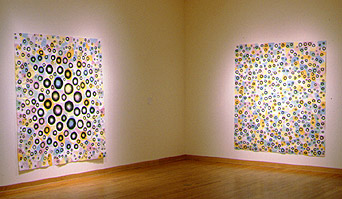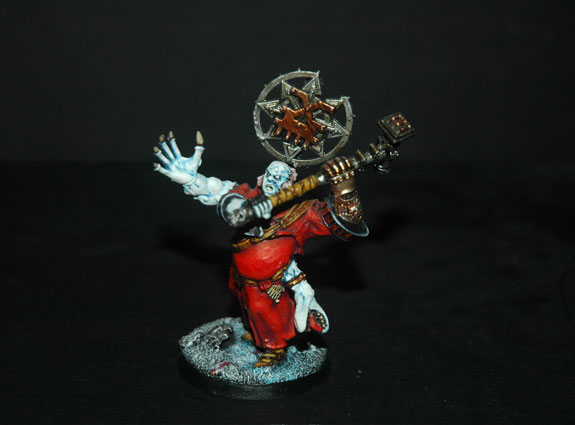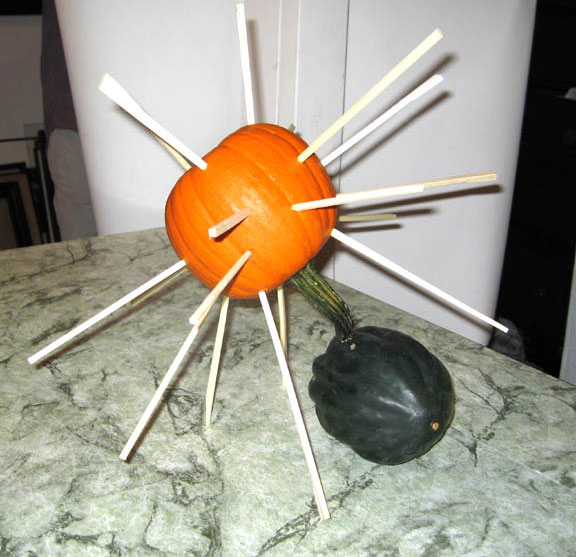View current page
...more recent posts
"Protest Song (Human Crab Louse)" [mp3 removed]. Work in process? Probably more like a prototype. The "found sequence"-- an Electribe rhythm pattern slowed down by about 16 bpm and reinterpreted by the computer as a melody kind of trails off into inconsequentiality every few bars, and that could be made more catchy and bouncy. The melody, such as it is now, sounds good in other Sid patches, to my ears at least, and those could be incorporated into the song with MIDI program change messages. One thing I learned is I don't have my volume problem with the analog drum machine if it's only playing a few hits (e.g. one kick, snare, clap, and one hi hat). It was only when I tried to use the full range of the machine that I had to turn the gain down--this tune is punchier and I didn't have to drop the volume.
A friend emailed to say he finds the synth sounds I'm using to be a little too much like factory presets--what come packaged with the instrument before any user programming. He says he's not sure if it's "the lack of layering, or that they're dry and don't have many filter/pitch/mod/etc controls." He likes the "Guitar Solo" video, though. I replied:
Thanks for the suggestions. I haven't made any pretense on the page of using anything other than presets. My feeling is MSPaintbrush is one big preset, and your suggestions would be like telling me I should use more layering and effects in Photoshop, to try to be more naturalistic and painterly. Not saying I'm not listening and won't absorb some of [the ideas in your email], but I like things straightforward and stupid. The guitar solo was a total one-off, I had just bought Kontakt and started turning as many knobs as I could find--it started getting distorted. The piece got more interesting when I started chopping the notes up and repeating them in a Wav editor. There's really no layering. It's just off the shelf distortion and brute surgery.
But I'm interested in the compositions being some basic, minimal, easily apprehended structure as opposed to building up a lot of texture in the sound. In "Clip City" I meant to contrast the subtle drumming with that dorky keyboard arpeggio I wrote and played absolutely dry on the Sidstation. The thought of doing a fluid, Basic Channel type drum track appealed to me, but then I just rebelled. The only analogy I can come up with is bad painting. Why would you want to do something bad when you can do something well? (A dealer once asked me that.) On "Permanent Chase" I added a little chorus effect to soften the Sid, but it's totally preset city. I really like the sounds those Swedish guys programmed! I've been lurking on some electronic music chatboards and am amazed by some of the complex things people are doing with drum programming etc. But I find the glitchy granular sound overrefined and boring. My favorite techno music is blindingly obvious. I think maybe I don't care about layering and quantizing because I like to hear all the instruments, and I like machines to sound like machines. Kraftwerk always appealed to me because it was wind up music, like looking at the inside of a watch and seeing how the gears move.
My friend replied that part of his confusion about the music was "that it's kind of sitting somewhere between german trance and a more minimal conceptual sound work, and I guess my personal preference would be for it to be a little more one way or the other." I'm abbreviating his comments, which were fairly detailed in how the music could go in either direction. I appreciate the suggestions but I'm resisting, as I explained in my emailed reply:
I guess my feeling is "german trance" and "minimal conceptual sound work" are both known genres, with their own sets of conventions, but the space between the two is maybe not to so mapped out. I'm not just trying to turn your criticism into a compliment. I think all my best work occupies that awkward middle ground between "failed commercial art" and "conceptualism with imagery too stupid to look at."
Where I'm still a little uncertain is, do I really need to learn to make good trance with all those subtleties you mentioned, or is it possible to fail at it for artistic purposes with only a working half-knowledge?
Part of me would like to be a club star with German girls putting their hands in the air, which is maybe why the music gets better without being entirely there as dance music. I keep working at it because I like it.
But trance is basically a dead art form. What is the point of getting really good at it?
Sounds like maybe the one that's bugging you the most is "Lysergic Interlude"? Those are definitely presets, from the Linplug Alpha softsynth: one is called "club run." I can hear everything you're criticizing about its lack of subtlety, but at the end of the day I just like that wind-up music box feel. (I subtitled it "Ice Cream Dude Sells E" because it sounds like an ice cream truck to me.) And there's almost nothing conceptual about it.
Anyway, I know the music's not perfect. I'm just leery about improving it too much because I don't know how relevant or valid "good" techno is at this point. I also feel the deconstructive art things (with sustained loops etc) are either too familiar or not fun. (Not saying [your piece you described in the email] is bad--I'm sure it's great.) There was a lot of finesse in the music in the Whitney's BitStreams show but not one composition had a beat or a melody. My hope is to keep working in the middle ground and a few good things will emerge from that process
And is if that wasn't enough, I added in a later email:
The bigger philosophical issue for me is the same issue I faced as an visual art student years ago. I had a teacher who left a note in my portfolio at semester-end saying I needed to "face very squarely" whether I was a cartoonist or an artist, because he saw the former winning out most of the time. Arguably he was right and that's why I [am where I am today], ha ha. As for making "good" techno--part of me wants to, but part of me wants to stay innocent and incorporate the misconceptions, fixes and workarounds of the self-taught musician into the final product, which loiters irritably halfway between trance and conceptual art. (The musical equivalent of my paintings, maybe.) BTW, the recent songs that matter the most to me are "Posse on Greenwich," "Glitch Western," and "Robollywood," none of which are actually that trancy.
Is it possible to contribute to a Tom DeLay legal offense fund? That sleazy criminal, sorry alleged criminal, has all the money in the world to out-lawyer and out-maneuver the poor beleaguered public official who finally indicted him. Like today, his successful tactic of getting the judge in his money laundering trial replaced because the man made some contributions to the Democrats.
What is it going to take to get rid of DeLay, the human crab louse? I'd give a hundred dollars to Ronnie Earle in Austin. Anybody else?
 An excerpt from the interview Cory Arcangel did with me at Rhizome.org [dead link - see below]:
An excerpt from the interview Cory Arcangel did with me at Rhizome.org [dead link - see below]: "The computer still has the shock of the new, or the shock of the bad in some cases. Art world folks know painting, photo, and printmaking lore, but are less secure--myself included--knowing what constitutes talent on the computer as opposed to some easy-to-do technical trick. I thought because everyone had Paint or the equivalent on their computer and had at least made a mark or spritzed the spraycan, they could see that I was doing something more ambitious with it. I was thinking of this guy in New Mexico who made perfect perspective drawings using an Etch a Sketch. If I could draw La Femme Nikita from scratch on this toy program and actually have people (well, guys) say she's hot, then a landmark would be achieved for both Paintbrush and the computer. The problem is I drew her so realistically people assumed I was running a photo though a pixelating filter.
"When I talk about craft on the blog, just to make it clear, I'm not talking about drawing ability but things like mosaics and needlepoints that relate to the computer on a much more fundamental image-making level, the grid level. I love the cross-stitch patterns and beadwork you can find online based on MSPaint drawings. In the late '90s I was impressed by the writing of cyberfeminist Sadie Plant, who opened up for me a whole organic, non-analytical way of looking at computation. She traces digital equipment back to one of its earliest uses, as punchcards for looms, and talks of the internet as a distributed collaborative artwork akin to traditionally feminine craft projects At the time I was drawing and printing hundreds of spheres at work and bringing them home, cutting polygons around them, and then taping the polygons back together in enormous paper quilts. In my press release for the Derek Eller show we called it 'corporate tramp art.'"
Update: New Link to Cory's interview with me.
Continuing my unbirthday celebration, this image arrived by email, with the caption INVINCIBLE. Another gem. Thanks to Diana and Matthew, and Luke for the badass figure.

"Permanent Chase" [mp3 removed]. The second in a projected series of "quieter" pieces for drum machine and Sidstation. The first was "Clip City" [mp3 removed]. They're not really quieter, they're just not as compressed as my other audio so they don't explode out of a pair of computer speakers. Bump the volume a bit and they're "loud enough." [Update: I've since made both of these tracks louder; these are the quiet versions.]
On "P. C.," yes, the lead is repetitive and dumb. It's supposed to be kind of a joke. And the key change at the end is also a bit of a joke after all the repetition (bad musicians use gratuitous key changes to hide a thin song). For those who might think I use only presets and dry, out of the package synth sounds, generally I like'em but these pieces actually got a fair amount of tweaking. As I explained in an earlier comment:
I've been using controllers (knobs and curves) in a lot of the work. Mostly cutoff filter/resonance, some LFO vibrato and sweeps. In "Permanent Chase" I used a controller to detune one oscillator, that's how I did my "key change." The drums in "Clip City" were filtered using LFO to change the envelopes, and "Permanent Chase" had three 45-second "movements" each using its own distinct filter settings (the Mutator effects filter in two of them plus Spektral Delay in the third). Each part was mixed down separately, run through noise reduction then cross faded so it appeared to morph out of the one that preceded it. This was all in the drums. The Sid had chorus plus the detuning. Maybe I should be proud that everything still sounds "out of the box."
My birthday falls, um, around Halloween (we ain't all sentimental on this blog so that's all I'm sayin'). Stephen and Andrea carved a pumpkin in my honor and named it Tom. Thanks, guys, it's beautiful.

I've been having an interesting discussion offline about the "confusing" nature of my recent music. A listener suggested that if it's German trance or house I'm going for, it should be more sophisticated and varied, with more filtering, pitch-shifting, layering of sound, use of quantizing to give more swing to the rhythm, and less use of factory presets. If it's conceptual art (as in Yoko Ono or Philip Glass minimalism--my examples), it should be a lot clearer that's the frame of reference. As it is, the listener says, the music is somewhere in the middle and needs to lean one way or another.
Maybe what set him off was a piece I just posted, called "Permanent Chase," which took a one bar "found" melody and pretty much beat it to death. Composing for me isn't about spending hours in the lab creating new synth sounds--it's more about taking what's there and using it to just to the point where you're about to scream and then tossing in one little change that brings some closure. Maybe with that piece I failed (too many bars before the goofy key change? maybe if snipped out about 8-16 bars?). I've pulled it pending further study 'cause I'm not sure myself.
Generally speaking, though, I like that middle ground he's talking about. My visual work has always occupied a realm somewhere between "failed commercial art" and "conceptualism that's too stupid to look at." I certainly started out doing music with that mindset. I've been grinding out so much of it lately that maybe it's starting to get "good," as in, one wants to hear it be "better." That may be the time to walk away from it. My hearing would probably thank me.
